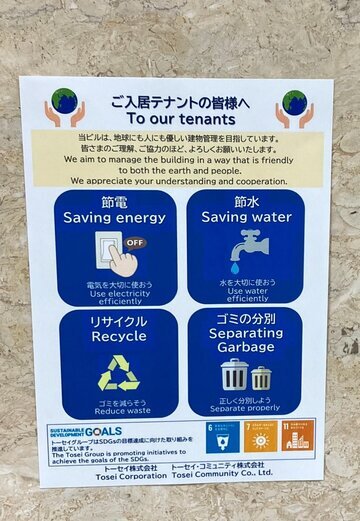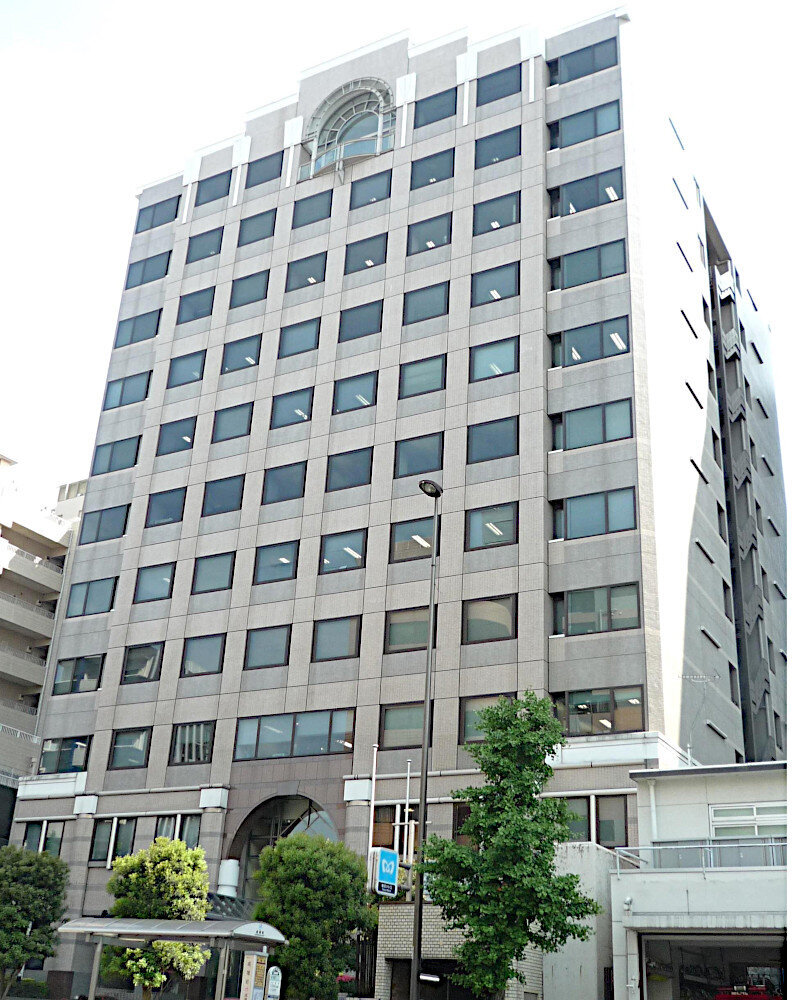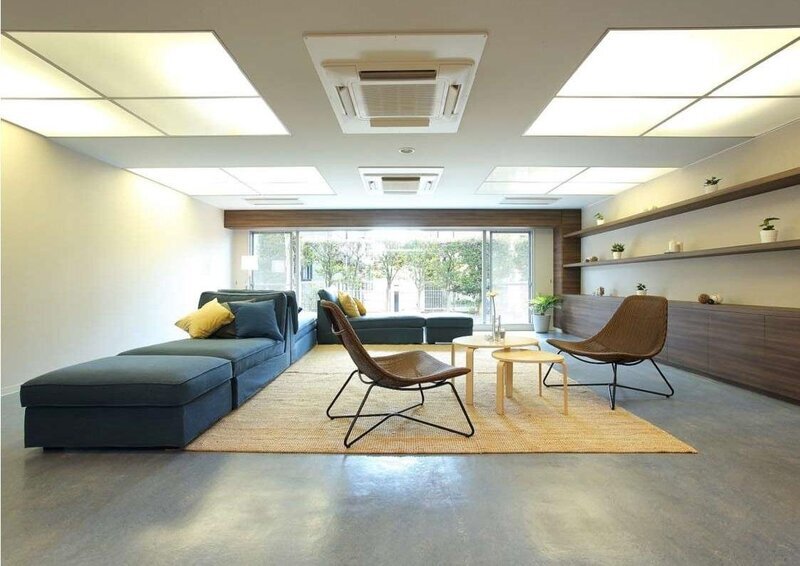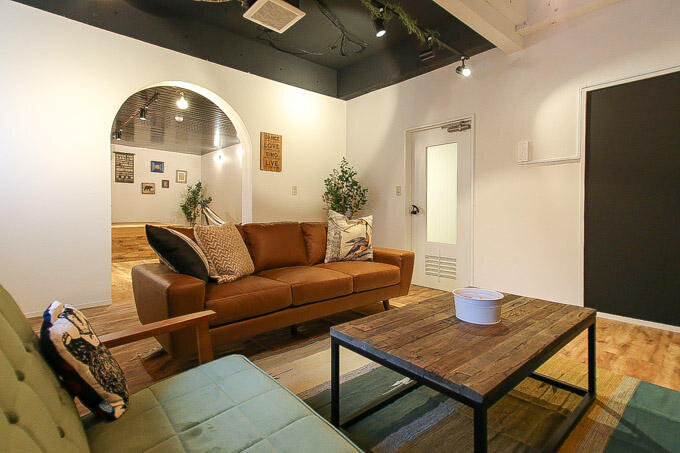Environmental Pollution and Resources
Approach to Environmental Pollution and Resource Conservation
In addition to complying with all applicable laws and regulations regarding environmental pollution and taking appropriate measures, the Tosei Group Environmental Policy stipulates that the Group will strive to prevent environmental pollution, promote resource conservation such as reducing, reusing and recycling, and promote efforts to reduce environmental impact and create a circular economy.
Pollution Prevention
Risk Management
When considering the acquisition of land or buildings, a "Real Estate Purchase Check Sheet" is completed and reviewed for all projects as part of the property purchase due diligence flow. We conduct a geo-historical survey of the property to be acquired and, if necessary, a soil contamination survey. In addition, depending on the age and structure of the property, we conduct asbestos inspections and other hazardous material inspections to ensure risk management against contamination.
Soil Contamination Countermeasures
As part of the property purchase due diligence, further contamination investigations are conducted according to the results of the geo-historical survey. If the results confirm contamination by hazardous substances, development activities are conducted after appropriate soil improvement and spread prevention measures are taken by a designated contaminated soil treatment company in accordance with the Soil Contamination Countermeasures Act.
Hazardous Materials Treatment
When acquiring an existing property and demolishing or renovating it, we conduct a thorough preliminary confirmation with the demolition or renovation contractor in order to comply with relevant laws and regulations, including asbestos surveys, and take appropriate measures to prevent the dispersal of harmful substances such as asbestos and chlorofluorocarbons. In the event that treatment or management of specially controlled industrial waste becomes necessary at any of our buildings, we will dispose of them appropriately in accordance with laws and regulations. In the development of our buildings, we use building materials that meet JIS and JAS standards for low emission of formaldehyde, a substance that causes sick building syndrome, in an effort to provide safe and secure housing.
scroll
| Item [Unit] | FY2020 | FY2021 | FY2022 | FY2023 | FY2024 |
|---|---|---|---|---|---|
| PCB waste [t] | 0.76 | 0 | 0 | 0 | 0 |
-
*Coverage: Tosei Corporation
-
*As of November 30, 2024
Soot and Smoke Measurement
In order to comply with environmental standards under the Air Pollution Control Law, our group periodically measures soot and smoke at facilities subject to control by law and confirms that emission standards are met before operating such facilities.
スクロール
| Item [Unit] | FY2021 | FY2022 | FY2023 | FY2024 |
|---|---|---|---|---|
| Nitrogen oxide (NOX) [g/㎥] | 0.086 | 0.100 | 0.101 | 0.054 |
-
*Coverage: Tosei Corporation
-
*As of November 30, 2024
Waste Reduction
Waste Reduction Targets
The following reduction targets have been set for waste reduction.
- Long-Term Target
- Reduce waste discharge intensity (kg/㎡) by 15% by FY2050
- Medium-Term Target
- Reduce waste discharge intensity (kg/㎡) by 5% by FY2030
- Coverage
- Tosei Group's head office buildings
- Base Year
- FY2022
- Long-Term Target
- Reduce waste discharge intensity by 2.5% in 5 years
- Short-Term Target
- Reduce waste discharge intensity by 0.5% in 1 year
- Coverage
- Tosei Group's head office buildings
- Base Year
- FY2018
Waste Discharge Results
Scroll
| Item [Unit] | FY2022 Results (Base year) |
FY2030 Target (Target year) |
FY2050 Target (Target year) |
FY2018 Results | FY2019 Results |
FY2020 Results |
FY2021 Results |
FY2022 Results |
FY2023 Results |
FY2024 Results |
|
|---|---|---|---|---|---|---|---|---|---|---|---|
| Waste discharge | Total amount [t] | 126 | - | - | 60 | 67 | 71 | 100 | 126 | 121 | 107 |
| Incineration/landfill [t] | 87 | - | - | 22 | 23 | 33 | 49 | 87 | 84 | 76 | |
| Recycle [t] | 39 | - | - | 38 | 44 | 38 | 51 | 39 | 37 | 32 | |
| Waste discharge intensity [kg/㎡] | 8.27 | 7.86 | 7.03 | 13.27 | 14.84 | 15.70 | 8.37 | 8.27 | 7.95 | 7.04 | |
| Reduction rate compared to base year (waste discharge intensity) | - | -5% | -15% | - | - | - | - | - | -4% | -15% | |
| Total floor area of the coverage [㎡] | 15,249 | - | - | 4,515 | 4,515 | 4,515 | 11,986 | 15,249 | 15,249 | 15,249 | |
-
*Occupancy rate is not taken into account in the calculation of floor area intensity.
-
*As of November 30, 2024
Waste Reduction, Sorting, and Recycling
Collection and Donation of Plastic Bottle Caps Through the NPO Ecocap Promotion Association
The Group participates in the Ecocap Movement in cooperation with the NPO Ecocap Promotion Association. By collecting and donating used plastic bottle caps from Tamachi Tosei Building, we promote social contribution from various aspects such as recycling into reusable plastic materials, reducing CO2 emissions, supporting medical care, and promoting employment for the disabled and elderly. In FY2023, 74.10 kg of plastic bottle caps were collected and donated.
Efforts Through Tenant Communication
We conduct periodic surveys of tenants in our properties regarding building management and operation systems, facilities, etc. to understand their needs. In terms of waste reduction, separation, and recycling, we have been taking various measures, such as putting up posters encouraging cooperation in separation and recycling, installing trash cans for separation, and posting information on how to dispose of, separate, and recycle trash at trash disposal sites.

Resource Conservation
Water Resource Conservation
In promoting efforts to conserve water resources, the following reduction targets have been set.
- Target
- Reduce water use intensity (㎥/㎡) from the previous year
- Coverage
- Tosei Group *
-
*Real estate portfolio with substantial energy management title among Tosei-owned fixed assets
- Long-Term Target
- Reduce water use intensity by 2.5% in 5 years
- Short-Term Target
- Reduce water use intensity by 0.5% in 1 year
- Coverage
- Fixed assets owned by the Company
Water Use Results
Scroll
| Item [Unit] | FY2018 | FY2019 | FY2020 | FY2021 | FY2022 | FY2023 | FY2024 | |
|---|---|---|---|---|---|---|---|---|
| Water withdrawal | Total amount [㎥] | 87,889 | 97,198 | 70,436 | 83,161 | 144,712 | 174,179 | 201,742 |
| Fresh surface water [㎥] | 0 | 0 | 0 | 0 | 0 | 0 | 0 | |
| Brackish surface water/sea water [㎥] | 0 | 0 | 0 | 0 | 0 | 0 | 0 | |
| Underground water [㎥] | 0 | 0 | 0 | 0 | 0 | 0 | 0 | |
| Tap water [㎥] | 87,889 | 97,198 | 70,436 | 83,161 | 144,712 | 174,179 | 201,742 | |
| Water withdrawal intensity [㎥/㎡] | 1.35 | 1.23 | 0.79 | 0.74 | 1.05 | 1.23 | 1.96 | |
| Reduction rate compared to base year (Water withdrawal intensity) | - | -9% | -41% | -45% | -22% | -9% | - | |
| Wastewater | Total amount [㎥] | - | - | 67,674 | 79,859 | 141,218 | 170,256 | 201,740 |
| Fresh surface water [㎥] | - | - | - | 0 | 0 | 0 | 0 | |
| Brackish surface water/sea water [㎥] | - | - | - | 0 | 0 | 0 | 0 | |
| Underground water [㎥] | - | - | - | 0 | 0 | 0 | 0 | |
| Sewage [㎥] | - | - | 67,674 | 79,859 | 141,218 | 170,256 | 201,740 | |
| Wastewater intensity [㎥/㎡] | - | - | 0.76 | 0.71 | 1.03 | 1.20 | 1.96 | |
| Total floor area of the coverage [㎡] | 65,304 | 79,079 | 88,597 | 112,622 | 137,499 | 141,306 | 102,905 | |
-
*Wastewater discharge has been monitored since FY2021.
-
*The coverage through FY2023 is Tosei-owned fixed assets. This excludes those with an energy monitoring period of less than one year, condominium unit ownership properties, and real estate for sale.
The coverage after FY2024 is the real estate portfolio with substantial energy management title among Tosei-owned fixed assets, and which is subject to the Act on Rationalizing Energy Use. -
*Occupancy rate is not taken into account in the calculation of floor area intensity.
-
*The base year shown in this table is the base year in the old target through FY2023 (FY2018) . There is no base year in the current target.
-
*As of November 30, 2024
Installation of Water-Saving Equipment in Owned Properties
To conserve water resources, the Group promotes water-saving construction for toilets and other water facilities in its fixed assets. To date, water-saving renovation work has been carried out at Awajicho Tosei Building, Yotsuya Tosei Building, and Narimasu Tosei Building.



Business Activities in Water Stressed Areas
The Group regularly assesses water stress and water risk in our main business areas (Tokyo, Kanagawa, Chiba, and Saitama prefectures) using Aqueduct, the assessment tool of the World Resource Institute (WRI). As of September 2024, there were no areas classified as "High" or higher for water risk.
Environment-related Violations and Fines
There were no penalties or fines for violations of environment-related laws and regulations (including water-related) or accidents in FY2024.
Initiatives Through the Revitalization Business
In our Revitalization Business, existing buildings are utilized to enhance their value, which has less impact on the environment and conserves resources compared to rebuilding. In order to make the most of the individuality of a wide variety of existing properties and further enhance their attractiveness, we consider a revitalization menu with "Well-being," "Eco Friendly," and "Resilience" as important guidelines, providing optimal value for owners and tenants.
Utilization of Idle Company Housing
In recent years, company housing has been increasingly decommissioned and left vacant as companies reassess their assets, contributing to the growing problem of vacant housing in cities. We are working to supply new rental housing to the market while making effective use of the existing buildings by purchasing unused company housing and enhancing the value of the property.
Case 1: Improvement of soundproofing performance (T-Rhythmic SOKA)
This property was built as a company dormitory and had been vacant. In addition to soundproofing all of the studio units, a lounge for concerts and a storage room were newly built, and the property was revitalized as a rental apartment for music lovers.

Case 2: Establishment of new common facilities (T's garden Kitakashiwa)
This large property was once developed as a company housing for families, which was transformed into a rental apartment with three new common facilities: a study room, kids' room, and party room, which are as extensive as those in condominiums.

Case 3: Renewal to a share house (ARDEN Fujigaoka)
A former company dormitory was extensively renovated and revitalized as a share house. Existing space was effectively utilized by converting an unneeded shared bathroom into a lounge and renovating the hot water supply room into a shower room.

Case 4: Enhancement of disaster prevention and green conservation (T's garden Nishiterao)
The company housing, which had become vacant and nearly abandoned, was acquired, and three themes were established: "green conservation," "disaster prevention and crime prevention," and "energy and resource conservation. The company aims to contribute to SDGs by upgrading the value of the property with facilities and specifications in line with the themes.

Case 5: Installation of solar panels and storage batteries (T's eco Kawasaki)
The condominium was revitalized as a rental condominium with the theme of promoting ecology throughout the entire condominium, with the installation of LED lighting and other energy-saving equipment in both common and private areas, as well as our first solar panels on the rooftop.

Adoption of New Eco-friendly Materials for Employees' Business Cards
The Group changed the material of business cards used by the Group's employees to LIMEX. This material is eco-friendly because almost no water or trees are used. The Group aims to reduce the amount of paper used and raise environmental awareness among employees by replacing business cards, the use of which reaches 500 pieces per person every year, with those made of eco-friendly materials.